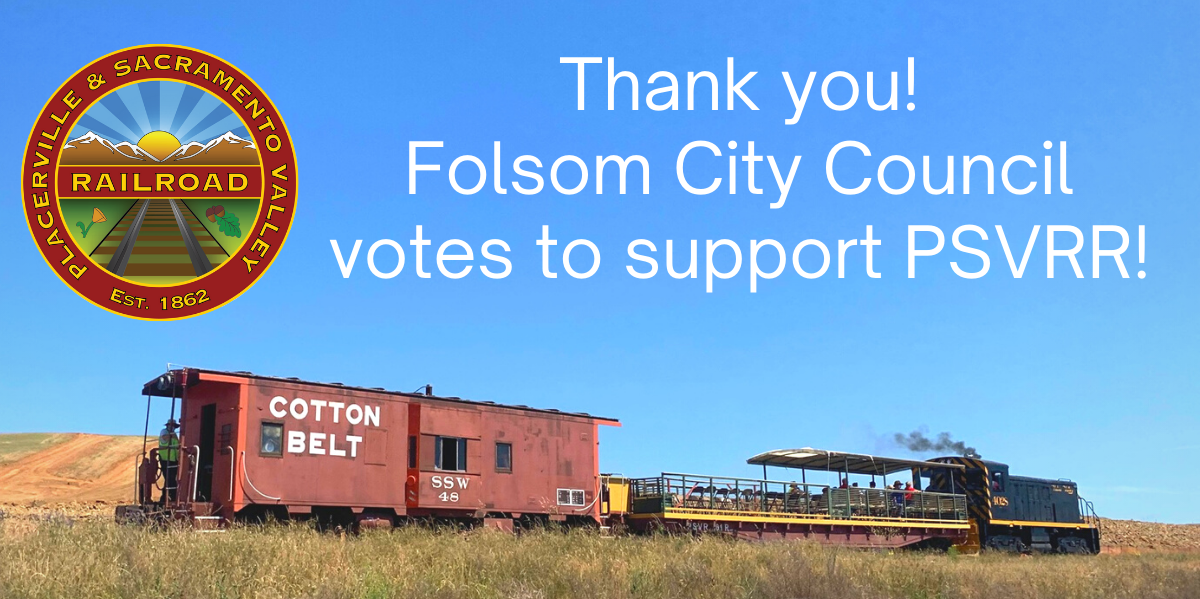(This story originally appeared in Folsom, El Dorado & Sacramento Historical Railroad Association‘s Spring 2017 newsletter)
Real Transportation – By Jim Matthews
On March 18, 2017, we welcomed a number of William Jessup University’s international students, most of whom are Chinese, to our historic Placerville & Sacramento Valley Railroad and surrounding territory. We wanted to be sure they knew how important the Chinese were to the history of northern California. Back in 1848, when somebody out here whispered “gold” and triggered one of the larger mass migrations in history, the Chinese were among the first to arrive.
This gold discovery came at a time when there was no easy way to get from the eastern US to California. By ship, it would be 16,000 miles around the southern tip of South America. It was possible to get here in less than 2,000 miles, but that would be by fragile covered wagon on primitive trails across the yet-to-be civilized parts of north America. So either way, one would really have to want to get here. It was actually easier to get to California from Asia then from the eastern US, so many of the first gold seekers arrived from such locations as China, Japan, or Southeast Asia. Southern China in particular was a major source of Asian immigrants to northern California, At one time, nearly one third of northern California’s mining population was said to be Chinese. Large Chinese communities developed in places like Ione and Fiddletown.
In many ways, California seemed more in touch with Asia than the rest of the United States. This “Pacific Rim” economic and cultural affinity is still somewhat in place today. For example, present-day California growers frequently find it easier to sell their crops in Asian markets than in the eastern US.
At the beginning of the Gold Rush, California was, in many respects, going its own way as part of the “Pacific Rim.” With its gold, and all the commerce generated around it, the US government became concerned about keeping California in the Union, especially with Civil War becoming more likely. Railroad connection with the northeastern US could do a lot to facilitate California’s American identity.
Many Chinese moved into California to help with eastward or trans-continental railroad construction. In addition to providing labor on the original P&SV, Central Pacific, and other railroads, the Chinese themselves developed many of the innovative construction processes that made such projects possible. But in the 1860’s, Central Pacific Chinese laborers’ wages ranged from $28 to $35 per month for their sometimes hazardous work, even at the highest skill levels. By comparison, locomotive engineers of that day earned close to $100 per month, with firemen and conductors earning around $85 per month. One could argue that the Chinese laborers were undercompensated for their contribution. The US Government recently issued long overdue recognition to the Chinese who worked so hard building US railroads.
When Chinese and other workers built the trans-continental railroads, they did not just connect California, (and Washington and Oregon) with the rest of the United States. They connected the US with Asia. For example, for periods of time in 1877, an average of thirty eastbound freight cars per day loaded with tea and other Chinese goods were reported to pass through Battle Mountain, Nevada on the Central Pacific RR main line. And that did not count the Chinese originated traffic on other railroads of the time. Early US railroad builders welcomed opportunities for trade across the Pacific via steamship connection.


One way in which that goal was expressed was in the Chinese Yin-Yang symbol that became the logo for the Northern Pacific Railway, which operated between the upper US Midwest and Seattle, Washington. James J. Hill expressed similar desires to reach the Far East via the Great Northern, which operated between similar locations and northern California. The logos of both the Northern Pacific and Great Northern were actually based on the Asian monad. The silhouette of the mountain goat was added to the Great Northern logo later on. Great Northern owned the steamship SS Minnesota on which its passengers could extend their travel to or from Asian locations.
Today, many long eastbound trainloads of container traffic from Asia cross the US. When I worked as Manager of Intermodal Systems for Southern Pacific, I remember these Asian imports making it difficult to balance east and westbound railroad traffic throughout our system. Western US railroads, from their Gold Rush era beginnings to the present day, experienced a strong Asian effect on their transcontinental traffic.
The Gold Rush affected American commerce in many ways. It was during this time that the Chinese brought herbal medicine to the US. And it was then that a German immigrant named Levi Strauss designed, sold, and popularized appropriate clothing for gold prospectors.
The Gold Rush had its impact on American music. This was the banjo’s first major appearance in the US outside of the southeastern plantations. Gold Rush prospectors loved the banjo, and tended to write their own lyrics, usually about the gold they expected to find, to go with the popular tunes of the day. The tunes to Oh Susanna and Camp Town Races were among those that got this treatment. Other types of music came to California during the Gold Rush. It was the Chinese who brought the first Operatic performances to San Francisco. Others followed.

So, Northern California is the product of a unique combination of influences including gold, other countries, railroad routes and music. The result is a uniquely colorful heritage that needs to be preserved and understood.

